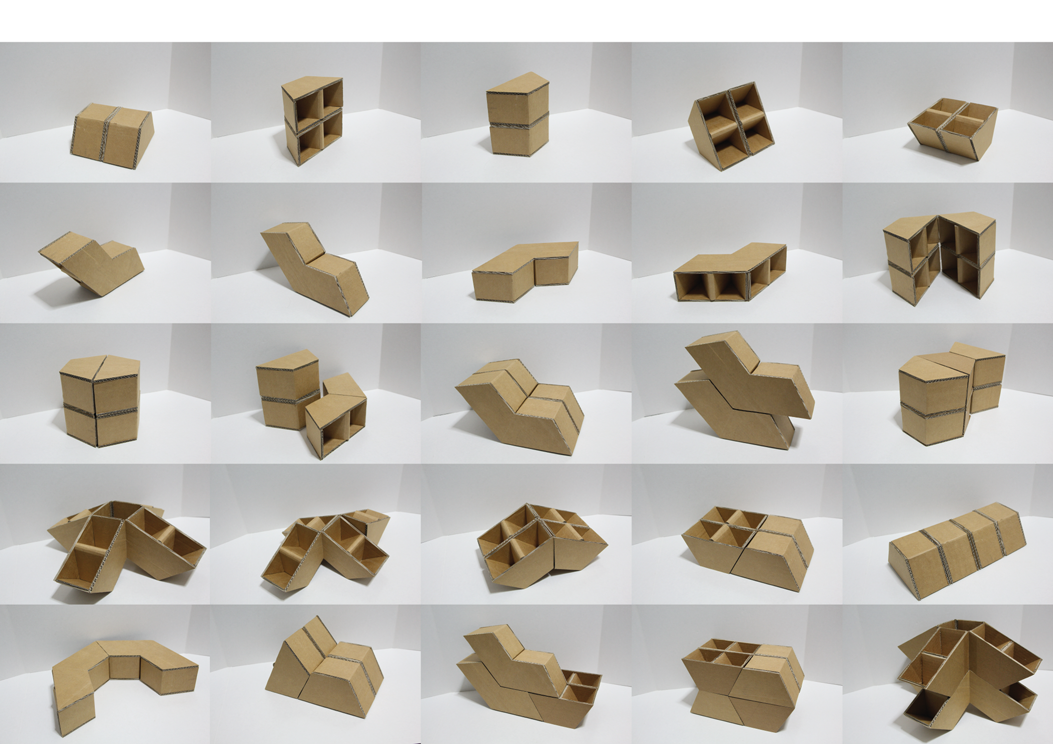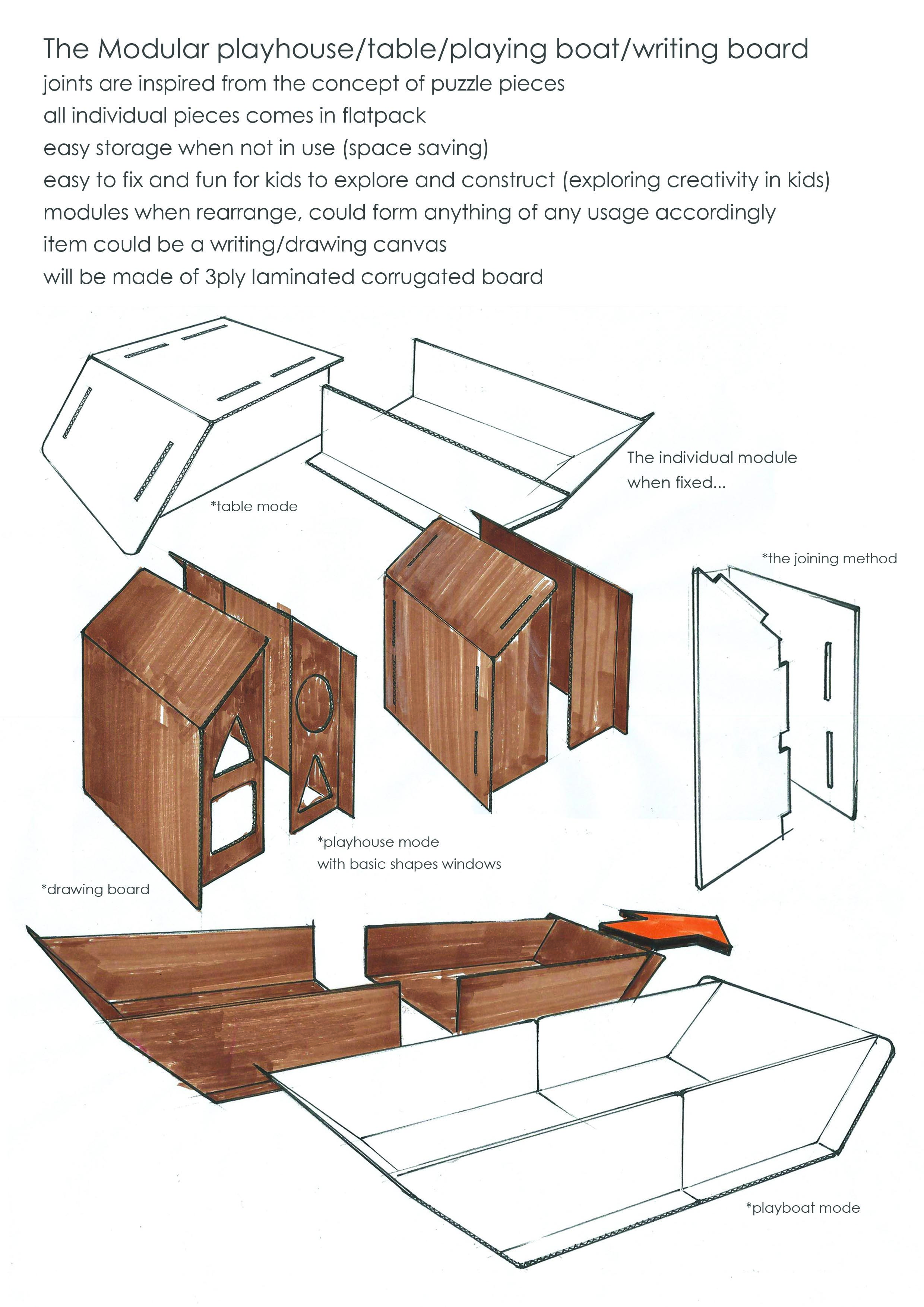Monthly Archives: September 2015
FYP 2nd Presentation pdf
Prototype video for the basic modular geometric concept
Watch a simple video of the prototype changing process here.
Do take note that the prototype is of 1:3 scale.
A basic prototype of modular/flexible structure concept
Basic sketch for a modular/flatpacked/multifunctional concept
Theme &Concept
The theme of my design is ‘Transformation’
Going back to the basics of shapes and colours, as features to make designs attractive to kids (preschoolers 3 to 5 yrs)
My inspirations includes the concept of building blocks and the game Tetris, puzzles and also the wooden matching shapes toy.
i would like to explore on designs that opens up to transform into something else…
as i would like to refer to a child’s growth and development in terms of the way they think and act
like the tiny leaves of a mimosa plant, it is sensitive to movement and touch… when the wind blows, it shy away and closes…
but after some time it opens up again…
as we apply this thought into a children’s mind, we cannot push the way they think or do things especially their creativity…
as most children would express their creativity and thoughts on canvas when they are all by themselves without any distractions
the elements of childhood development is an essential aspect that i would like to show in my design
my design will have these aspects that includes:
creativity eg. to create, construct or explore with the forms of the design like DIY making or joining modular designs
learning eg. learn about the material used and why we should recycle, teaches to think out of the box
management eg. learn to manage the space and organize toys after playtime
fun eg. to do anything and everything as to have fun like the design could be anything like a robot or a writing board as long as its fun
Puzzle and games eg. add elements of child-like games that requires a thinking process
An All in One design
this could be a table, a chair, a playhouse, a puppet house, a car, a shelf, a toy box…
up to the way the child perceives.
Ideas includes:
a modular structure which has repetitions that serves as building blocks for users to construct their product
a flat pack structure that could be fixed in any ways like a puzzle
or a intricate form of structure that opens and closes to serve multiple usable features
Suggested solutions to work on
When we consider cardboard as an alternative sustainable material, many would compare it with plastics. Mainly plastics that are used for bottles and other cheap and recyclable solutions.
There has always been controversies and issues over how safe are plastics especially after the various treatments and processes it gone through upon the recycling process and also manufacturing. In actual fact, both cheap materials Cardboard and Plastics are not actually cheap. The process to create and recreate them are perhaps not that cheap and easy. On the few previous posts, Plastics have to go through around 6 process during recycling whilst cardboard only one. Thus giving Cardboard a winning factor over its economical aspect and not forgetting that it is much more safer and easier to handle than plastics.
Some suggested solutions that i could work on for my target users *children-preschoolers (as researched previously)
-interactive modular playhouse that could be formed and fixed into some other small furniture
-mutli-function small furniture (detachable forms could be play around by kids like building blocks, to make some other forms etc.)
-push cars
-play kitchen
-study/play table, writing board and storage box all in one
apart from usable products for kids maybe it could be a learning tool for kids too…
eg. learn to recreate creative forms from the modular parts of the furniture
or
eg. learn to organize things, toys into the storage furniture
For now, i am still going to research on plastics and the issues so i could justify my material choice (cardboard) over it.
For the packaging design structures examples, i found a book in the library which shows several complex examples and its templates. I would try to experiment them on cardboard.
Flute Office (some inspiration) (my ideas)
They design Sustainable Furniture for Offices
http://www.fluteoffice.com/shop/content/25-flutepro-desk-assembly
as quoted from the website “The office of the future is here already – Adaptive, lightweight, life-enhancing, fun and inspiring. No more waste, just beautifully crafted products designed with nature in mind.”
Maybe, i would like to go with this direction of
moving towards greener solutions for the future…
making and designing usable ideas but keep in consideration on improving the environment…
keeping in mind about the various aspects which could convince the usage of cardboard material as a greener and economical choice…
Cardboard is everywhere, it is cheap to produce, easy to handle and it is Eco friendly etc. etc…
these aspects would be the supportive facts to the choice of the material for some future solutions now as natural resources are getting low and Recycling is the only was to move on…
But instead of Office furniture, I would like to go with a more fun direction which would involve user-material interactivity
for one example that i had in mind is a multi-forming kids playable-furniture
like a diy and modular cardboard pieces which could be built up to any form of kids furniture
kids could play and fix them around
The other idea is maybe to mix the elements of nature to my design
something to play with biodegradable aspects and plantation
like cardboard as a medium to grow plant with… a pot cum fertilizer etc.
Apart from that, I would like to justify on the usage of cardboard as a solution for kids playhouse/furniture etc…
We all know of the future of kids products, they will be used for only a certain period of time when a kid is of a certain age category… After which they grow up, stuffs will need to be replaced…
So where does this old stuffs go? It will either be thrown away or passed on to relatives etc.
Nowadays kids products are not cheap, They are quite pricey. A simple plastic vacuumed formed playhouse by TOMY can easily cost S$200.
So this comes the part where cost is a factor… If a cheap material is used as an alternative, consumers save more money and manufacturers save much more money and all of them are contributing to saving the environment in a way.
Getting or replacing kids playhouses/furniture might be more cheaper process.
Discarded cardboard products already have their future, They are easily recyclable as compared to other materials like plastic which has another 5/6 recycling processes to go through.
Waste statistics 2014 Singapore
Lets take a look at two major cost efficiency materials in the recycling industry.
Plastics and Cardboard.
As compared to plastics, there are more cardboard waste being recycled than its being disposed.
Information taken from:
http://www.zerowastesg.com/2015/03/18/singapore-waste-statistics-2014/

% Composition of Waste Generated
The top 5 waste types make up 75% of the total waste generated in Singapore, which are either disposed of at the waste-to-energy plants and landfill, or recycled locally and exported:
- Ferrous Metal (19%)
- Construction Debris (17%)
- Paper/Cardboard (16%)
- Plastics (12%)
- Food Waste (10%)
% Composition of Waste Disposed
The top 3 waste types make up 68% of the total waste disposed in Singapore:
- Plastics (26%)
- Food Waste (23%)
- Paper/Cardboard (19%)
% Composition of Waste Recycled
The top 3 waste types make up 74% of the total waste recycled in Singapore:
- Ferrous Metal (31%)
- Construction Debris (28%)
- Paper/Cardboard (14%)
Recycling Rate of Waste
For the 3 common types of waste disposed, the recycling rate for plastics and food waste is still low:
- Food Waste (13%)
- Plastics (9%)
- Paper/Cardboard (52%)
More efforts are needed to educate Singaporeans on reducing food waste and the use of plastics, and to increase the recycling of food and plastic waste.
For paper, there is still room for more recycling, as 48% of the paper and cardboard waste generated still ends up being burned at the waste-to-energy plants.
– See more at: http://www.zerowastesg.com/2015/03/18/singapore-waste-statistics-2014/#sthash.ZF8josLy.dpuf
One of a study on cardboard as an alternative in cutting prodduction cost
Cardboard tray system slashes bakers’ costs and could reduce retail bread prices
Replacing plastic trays with a cardboard system could allow US retailers to slash US bread prices while maintaining profit margins and lowering costs for manufacturers, says the maker of the new method Out of the Box.





